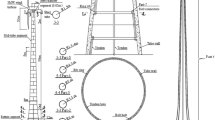Abstract
Innovative features of wind turbine blades with flatback at inboard region, thick airfoils at inboard as well as mid-span region and transversely stepped thickness in spar caps have been proposed by Institute of Engineering Thermophysics, Chinese Academy of Sciences (IET-Wind) in order to improve both aerodynamic and structural efficiency of rotor blades. To verify the proposed design concepts, this study first presented numerical analysis using finite element method to clarify the effect of flatback on local buckling strength of the inboard region. Blade models with various loading cases, inboard configurations, and core materials were comparatively studied. Furthermore, a prototype blade incorporated with innovative features was manufactured and tested under static bending loads to investigate its structural response and characteristics. It was found that rotor blades with flatback exhibited favorable local buckling strength at the inboard region compared with those with conventional sharp trailing edge when low-density PVC foam was used. The prototype blade showed linear behavior under extreme loads in spar caps, aft panels, shear web and flatback near the maximum chord which is usually susceptible to buckling in the blades according to traditional designs. The inboard region of the blade showed exceptional load-carrying capacity as it survived 420% extreme loads in the experiment. Through this study, potential structural advantages by applying proposed structural features to large composite blades of multi-megawatt wind turbines were addressed.
Similar content being viewed by others
References
Global Wind Energy Council. Global Wind Report: Annual Market Update 2013. Global Wind Energy Council. Brussels, Belgium, 2014
Refan M, Hangan H. Aerodynamic performance of a small horizontal axis wind turbine. J Sol Energ-T ASME, 2012, 134: 021013
Mo J O, Lee Y H. CFD investigation on the aerodynamic characteristics of a small-sized wind turbine of NREL Phase VI operating with a stall-regulated method. J Mech Sci Tech, 2012, 26: 81–92
Kwon H I, You J Y, Kwon O J. Enhancement of wind turbine aerodynamic performance by a numerical optimization technique. J Mech Sci Tech, 2012, 26: 455–462
Guo T Q, Lu Z L, Tang D, et al. A CFD/CSD model for aeroelastic calculations of large-scale wind turbines. Sci China Tech Sci, 2013, 56: 205–211
Huang C W, Yang K, Liu Q, et al. A study on performance influences of airfoil aerodynamic parameters and evaluation indicators for the roughness sensitivity on wind turbine blade. Sci China Tech Sci, 2011, 54: 2993–2998
Qin C, Ju P, Wu F, et al. Distinguishability analysis of controller parameters with applications to DFIG based wind turbine. Sci China Tech Sci, 2013, 56: 2465–2472
Chen X, Zhao W, Zhao X L, et al. Failure test and finite element simulation of a large wind turbine composite blade under static loading. Energies, 2014, 7: 2274–2297
Chen X, Zhao W, Zhao, X L, et al. Preliminary failure investigation of a 52.3 m glass/epoxy composite wind turbine blade. Engineering Failure Analysis, 2014, 44: 345–350
Jensen F M, Kling A, Sorensen J D. Change in failure type when wind turbine blades scale-up. In: Presentation at the 5th Sandia Wind Turbine Blade Workshop. Albuquerque, 2012
Overgaard L C T, Lund E, Thomsen O T. Structural collapse of a wind turbine blade-Part A: Static test and equivalent single layered models. Composites A, 2010, 41: 257–270
Paquette J, Dam J V, Hughes S. Structural testing of 9 m carbon fiber wind turbine research blades. In: Conference Proceedings of the AIAA Wind Energy Symposium. Reno, 2007
Ashwill T, Laird D. Concepts to facilitate very large blades. In: Conference Proceedings of the AIAA Wind Energy Symposium. Reno, 2007
Paquette J, Veers P. Increased strength in wind turbine blades through innovative structural design. In: Conference Proceedings of the European Wind Energy Association. Milano, 2007
Dassault Systemes Simulia Corp. ABAQUS/Standard User’s Manual, Version 6. 12, Dassault Systems: Providence, RI, USA, 2012
Wind Turbines-Part 1: Design Requirements, 3rd ed., IEC standard 61400-1, International Electrotechnical Commission (IEC): London, UK, 2005
Guideline for the Certification of Wind Turbines. Germanischer Lloyd: Hamburg, Germany, 2010
Author information
Authors and Affiliations
Corresponding author
Rights and permissions
About this article
Cite this article
Chen, X., Qin, Z., Yang, K. et al. Numerical analysis and experimental investigation of wind turbine blades with innovative features: Structural response and characteristics. Sci. China Technol. Sci. 58, 1–8 (2015). https://doi.org/10.1007/s11431-014-5741-8
Received:
Accepted:
Published:
Issue Date:
DOI: https://doi.org/10.1007/s11431-014-5741-8




